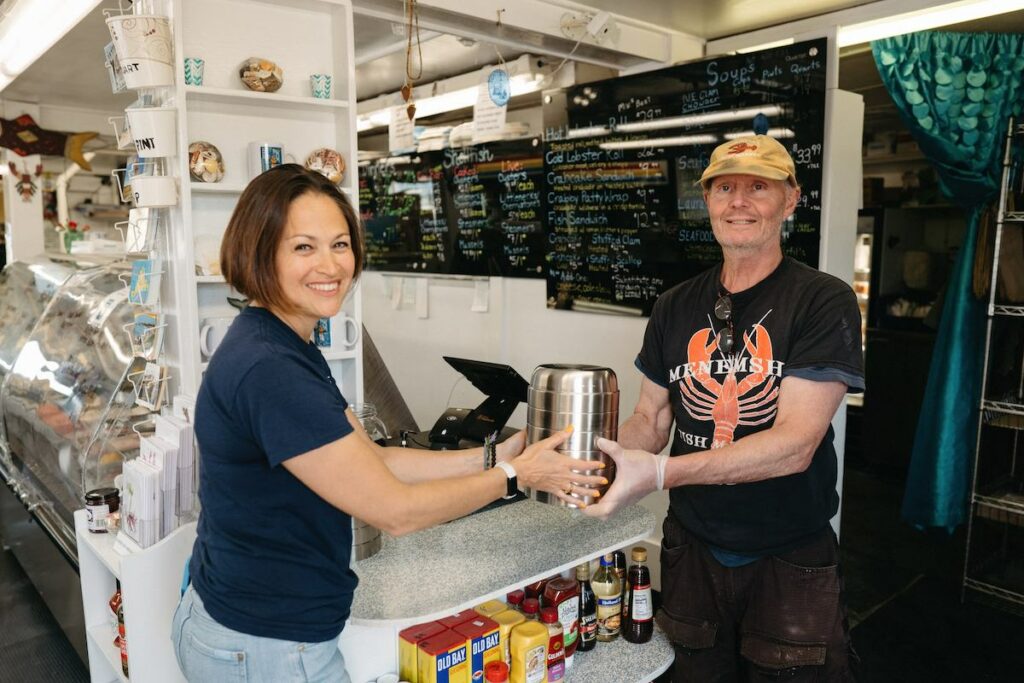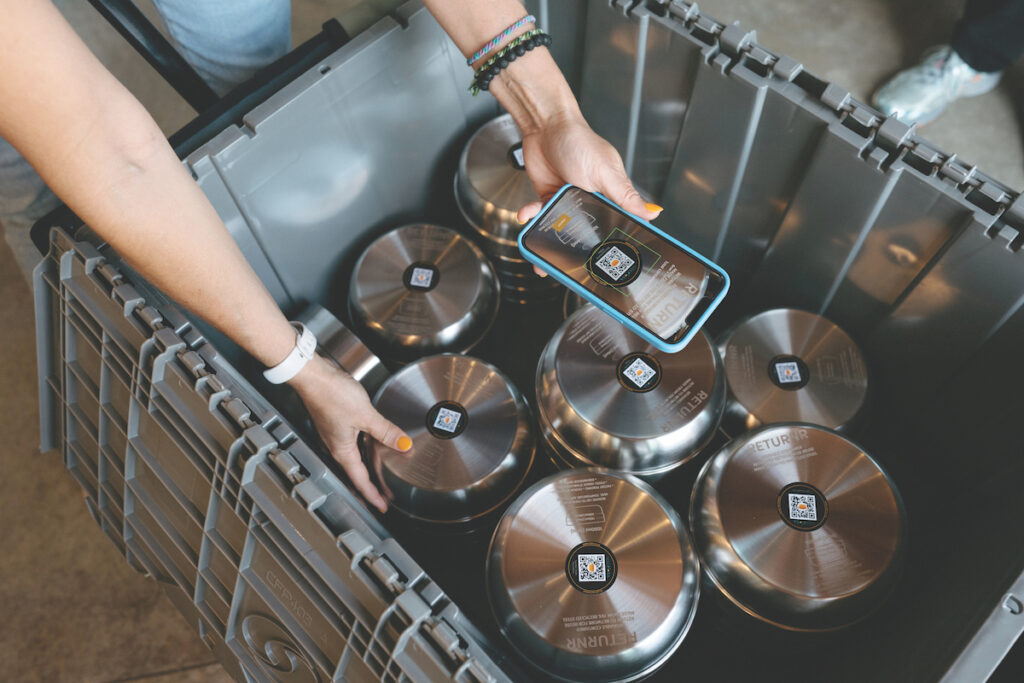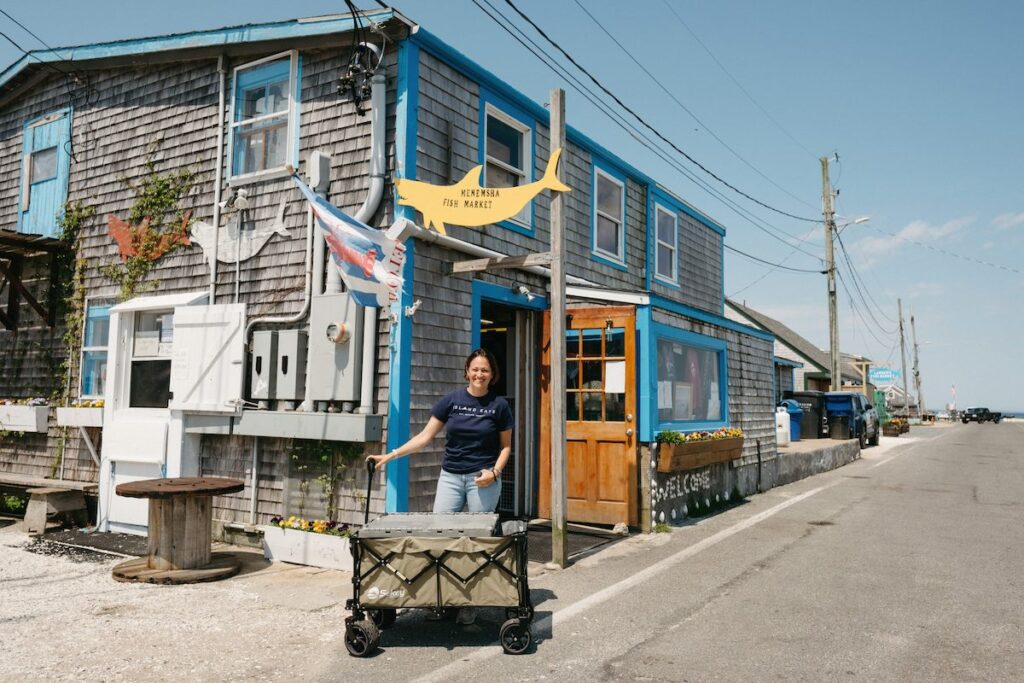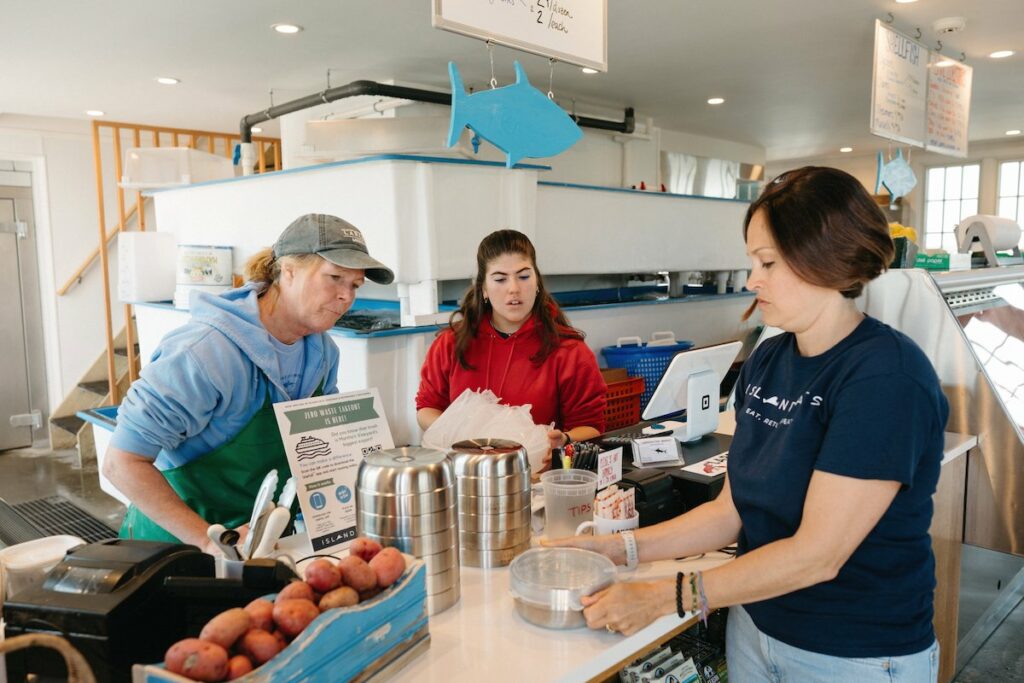Our writer spends the day as a fly on the dash of an important new venture.
When I was asked to pinch hit for the one-and-only Geoff Currier for an installment of his Cruising with Currier series, I knew it would be a fun and challenging experience. Geoff really gets to the meat of the story when he rides around with all these fascinating folks. When I walked up to Jessica Mason of Island Eats, who was parked in the West Tisbury library parking lot, the first thought that flashed into my head was “What would Geoff do?” The second thought was “Wow, what a cool Volvo.”
Mason is the creator of Island Eats, a program that seeks to reduce and eventually eliminate the material waste that comes from the food service industry on the Vineyard. It’s a big goal, but Mason is taking the necessary first steps. So how does an individual approach such a major problem? “Climate change and environmental protection can feel really daunting, like something that is impossible to solve,” Mason said. “Many of us want to do something to make a difference, but it’s hard to know where to start when it seems like the system is really stacked against us.”
Mason first thought about how she could empower folks to begin making environmentally-conscious decisions in their day-to-day lives. She decided to start by addressing the number one export from the Island — trash. During the pandemic, the Vineyard saw a drastic increase in the number of takeout containers being used, and Mason observed that even the so-called “compostable” containers were just being chucked in the garbage. Although scrutiny from environmental organizations and members of the public has caused most restaurants and businesses to start carrying cardboard (compostable) containers, Mason explained that those containers are lined with plastic that does not biodegrade. While theoretically a better alternative to plastic, these cardboard boxes do not break down in home compost, and the only composting facility here doesn’t accept those kinds of containers.
Mason first thought about how she could empower folks to begin making environmentally conscious decisions in their day-to-day lives. She decided to start by addressing the number one export from the Island — trash.
Through this realization, Mason started researching reuse systems in other places around the world, and quickly discovered that reuse isn’t a new concept, “it’s just new to the Island” she said. Even though plastic reusable containers are ubiquitous in the takeout industry, Mason said it was clear to her that switching over from single-use plastics to multi-use plastics would not be a sustainable solution. “We are still supporting the petrochemical industry, and we are still increasing the number of plastic containers that are produced. I heard from people early on that this would not be something they would support,” Mason said.


And that’s how Mason arrived at her beautiful double-walled stainless steel takeout containers as the centerpiece of her Island Eats operation. The containers that Island Eats circulates in the community are made of 75 percent recycled stainless steel (the rest is non-recycled) that insulates well and is extremely durable. Currently, they only have a single size bowl (40 ounces) that is versatile for many different meal sizes and types. The initiative is just a year in, and there are more ideas in the works, like introducing a soup container or sushi trays. Now, rather than buying a soda from a restaurant and enjoying it in a plastic or paper cup, folks can use the Island Eats system to get their beverages in 12- or 16-ounce stainless steel reusable mugs. Mason said it’s all part of giving people the opportunity to make a more sustainable choice.
The easiest way to explain Island Eats is that it’s like a library system. Folks have the ability to borrow the bowls from any participating restaurant, enjoy their food, then return the bowls to any restaurant that’s involved in the program. Users first download a phone app, called Useful, and then they have the option to enter into either a free membership or a paid membership. The free membership gives you access to the program, but you need to return your bowl (or mug) within twenty-four hours. The paid membership allows you seven days to return your bowl. Island Eats offers monthlong, summerlong, or annual paid memberships.
During my sunny ride-along with Mason in her fully-electric Volvo XC40, we drove the Menemsha route, delivering bowls to the Menemsha Fish Market and Larsen’s Fish Market. We also picked up the dirty bowls, which will go to a commercial cleaning facility to be made sparkly and sanitary and ready to be redistributed. Island Eats’ system uses a QR code at the bottom of each bowl that allows Mason to track where each bowl is on the Island, and whether a restaurant needs a new batch of bowls. By June, Mason expects that around twenty restaurants will be enrolled in the reuse program.
For Mason, having an electric vehicle for her program is all part of her broader investment in sustainability and green initiatives. “I absolutely love this car,” Mason said. “It’s comfortable and efficient, which is important when I am driving all around the Island delivering and collecting bowls.” Mason’s XC40 has some pretty cool features, like a 360-degree camera, supportive driver assistance that makes subtle adjustments as she drives, and an advanced cabin air filter. Altogether, it’s a pretty sweet and sustainable ride with plenty of space to accommodate Mason, our photographer, myself, and hundreds of stainless steel bowls.

There’s another pretty amazing perk to the Island Eats program: Mason can track the environmental impact users are having restaurant-by-restaurant, as well as at a systemwide level that provides a comprehensive overview of how much trash has been eliminated. “As we work with these restaurants, we are talking to them about sustainability and making suggestions for things they can do to lessen their environmental footprint,” Mason explained. “One of the easiest things they can do is stop posting photos on social media of food in these disposable containers. Normalizing the use of reusables is essential.” Island Eats users can also view their own individual reuse dashboard on the Useful app; it’s pretty empowering to see how much impact just choosing a reusable takeout container can make.
The easiest way to explain Island Eats is that it’s like a library system. Folks have the ability to borrow the bowls from any participating restaurant, enjoy their food, then return the bowls to any restaurant that’s involved in the program.
For Mason, top-down change is another important aspect of adjusting the paradigm around waste from the food service industry. Because board of health rules ban outside containers in a food preparation facility, no businesses on-Island allow folks to bring their own reusable containers. If, at the state level, regulation could be altered, it would essentially mean that Island Eats no longer has to exist. “That would be a wonderful thing. I am doing this to solve a problem we are facing now, but the systemic solution is to actually create policy at the state level,” Mason said.
Although there is no cost to restaurants that want to be a part of the Island Eats initiative, most partner businesses have agreed to offer a dollar off any item that customers get in a reusable Island Eats bowl. Mason hopes that will provide a good incentive to consumers to adopt this important practice. “[In] many other systems around the world that have seen success in this, the restaurants must bear the cost of participation,” Mason said. “We recognize that most Island restaurants have a very short season, so we are making it completely free.” Mason hopes that a combination of philanthropy and consumers deciding to choose paid memberships will balance the system and allow Island Eats to continue its good work.
After leaving the fish markets in Menemsha, Mason said the many partnerships Island Eats already has are a testament to the strength of community — to the kinds of amazing things our community can do when we work together. “I’m really energized when I go into a restaurant or business, and I see how excited and proud people are to be a part of this,” Mason said. “It’s really full-circle for me, because Betsy [Larsen] and Stanley [Larsen] have known me since I was a baby, and now I am partnering with them to do something really important.”
Mason’s dream for the Island is to broadly implement reuse in all restaurants, grocery stores, farm stands, and more. “We want reusable containers to become the standard, so that when someone goes into a restaurant and asks for a single-use container, that becomes the outlier,” Mason said. “We want folks to step in and say ‘hey, here on the Island we embrace reuse — we have a different way of doing things, and we invite you to join us.’”



How does one sign up for Island Eats?
Karen